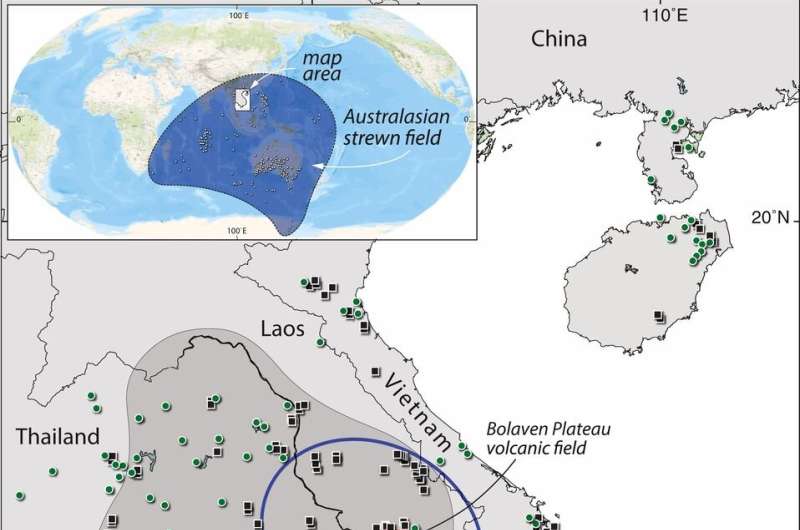The Bolaven Plateau volcanic field likely buries the impact crater that produced the tektites of the Australasian strewn field. It is the only adequately large and thick postimpact deposit on the Khorat Plateau, the largest region of plausible target rocks. It is also the only thick, postimpact deposit within the inner Muong Nong strewn field, the region containing exclusively nonaerodynamically shaped Muong-Nong–type tektites (circumscribed by the blue ellipse). Tektite find locations data from ref. 52 and this study. Basalt fields adapted with permission of ref. 53 and ref. 54; permission conveyed through Copyright Clearance Center, Inc. Outline of the Khorat Plateau data from ref. 55. Inset, finds of Australasian tektites and microtektites data from ref. 56 (white dots) define an asymmetric strewn field (blue). Credit: Proceedings of the National Academy of Sciences
A team of researchers with members from Singapore, the U.S., Thailand and Laos has concluded that the impact point of a meteorite that struck the Earth approximately 790,000 years ago lies buried beneath a volcanic field in southern Laos. In their paper published in Proceedings of the National Academy of Sciences, the group outlines four lines of evidence that point to the Bolaven volcanic field as the likely site of the meteorite strike.
Prior research has shown that approximately 790,000 years ago, a large meteorite (the largest known young meteorite impact) struck Earth in the Eastern Hemisphere. So great was the impact that debris was strewn across a tenth of the entire planet's surface. Scientists know about the impact because of bits of glassy clasts known as tektites have been found in places like Antarctica, Australia and Southeast Asia. Prior evidence also suggested the impact site was likely somewhere in Southeast Asia, but until now, the exact location has been unknown. In this new effort, the researchers have found evidence that suggests the reason the crater has not been found is that it is hidden beneath a volcanic field—and they provide four lines of evidence to back up their claim.
The first line of evidence involved the geochemistry of the tektites in the vicinity of the Bolaven volcanic field—the researchers claim it implies the presence of basalts at the impact site. The second line involved geologic mapping and dating of basaltic lavas that existed before and after the time of the impact, which showed a change occurred around the time of the impact. The fourth line of evidence came from gravity measurements the team took at the Bolaven volcanic field—they report an anomaly that suggests the presence of a 13- to 17-kilometer crater. The final piece of evidence came from what the team describes as an outcrop of crudely layered sandstone and mudstone boulders 10 to 20 kilometers from the Bolaven volcanic field, which appear to have been thrown there by the force of the meteorite striking the ground.
The researchers suggest that taken together, their four lines of evidence very strongly suggest that the impact site for the ancient meteorite was the Bolaven volcanic field.
More information: Kerry Sieh et al. Australasian impact crater buried under the Bolaven volcanic field, Southern Laos, Proceedings of the National Academy of Sciences (2019). DOI: 10.1073/pnas.1904368116
Journal information: Proceedings of the National Academy of Sciences
© 2020 Science X Network
























